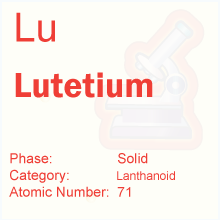 Periodic Table -> Lutetium
Periodic Table -> LutetiumLutetium
Lutetium DetailsLutetium Symbol: Lu
Lutetium Atomic Number: 71
Lutetium Atomic Weight: 194.967
What is Lutetium?
Lutetium is the last element in the lanthanide series, which is the series of the rare Earth elements. It is named after lanthanium, the first element in the series. These elements bear many similarities. Given that lutetium is the last element in the series, it is the hardest and the densest of all the elements in the group. It is a member of the d-block of the table unlike all the others in the series, which are located in the f-block. Lutetium is soluble in water and forms a compound with water molecules.
This element has the atomic number 71 and the symbol Lu. It was discovered in 1907 in France, Austria, and America independently. Eventually, it was determined that the discovery in France by Georges Urbain slightly predated the others and the honor went to him. He named the element lutecium. In 1949, the spelling of the element was changed, and it became lutetium. Earlier traces of the element were also found in the mineral ytterbia, but it was determined that it was a separate element. Previously, it was believed that the mineral was composed only of ytterbium.
The atom of this element has 71 electrons. In a chemical reaction, the atom loses its 5d electron and the two farthest from the nucleus. One peculiarity of the lanthanide series is that the size of the atoms decreases as the atomic number increases, which is why lutetium atoms are smaller than all the others of the elements in the series.
This element is silvery white in color, and it is resistant to corrosion and trivalent. Two isotopes of it occur naturally - lutetium-175 and lutetium-176. The first is stable, while the second has an amazing half-life of 3.78×1010 years. There are 32 man-made isotopes of lutetium. Their masses vary from 149.973 to 183.961. The radioactive isotopes of the element have half-lives of under 9 days, with most of them being under half an hour.

It has few known uses, and the reason is that lutetium is rare and expensive. The element is found in small amounts with other rare-earths, but it is difficult to separate it from them. Some radioactive isotopes of lutetium are used in nuclear technology as a way to date meteorites. Since it co-occurs with yttrium frequently, the compound is used to catalyze different reactions, as well as in metal alloys. One of the isotopes of lutetium is also used to treat tumors. Another use of lutetium is in cracking petrol in refineries, polymerization, and hydrogenation. In addition, the element is used in magnetic bubble memory devices by adding it to gadolinium gallim garnet.
The main mining sites are located in Australia, Sri Lanka, India, Brazil, the United States, and China. The world reserves of lutetium are estimated at about 200,000 tonnes. The annual production of lutetium is around 10 tonnes, in the form of lutetium oxide.
Those working with this element should keep in mind that inhaling lutetium fluoride is dangerous. The element is mildly toxic when ingested, but the soluble salts of lutetium are non-toxic. Similar to other rare-earth metals, this element is said to have a low toxicity rating. However, the compounds of lutetium should be handled with care. Metal dust of the element is an explosion and fire hazard. Lutetium poses no threat to animal and plant life.
You can
link to this page, using the code below:
Periodic Table |
Banks
© ElementsDatabase.com 2015 | Privacy | About | Contact